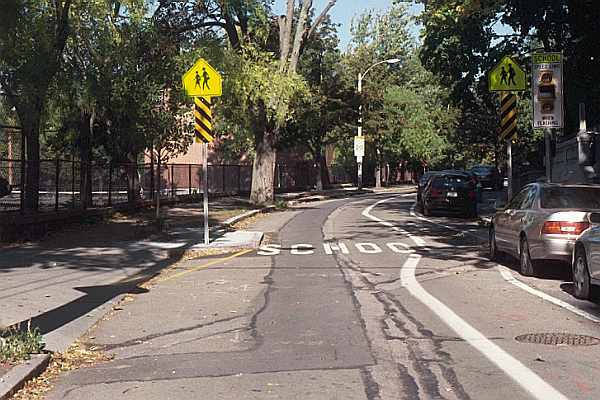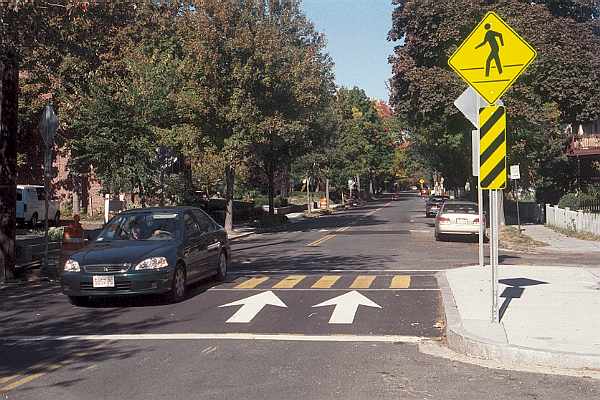Top: Home Page
Up: Table of Contents
Previous:
Next:
BROOKLINE BIKE LANE ON
|
![]()
| In front of the school there is a pedestrian crossing, with a bulbout on either side. The bike lane swerves to the right to maintain the width of the lane for motor travel, as shown in the next photo. |

What messages does this treatment send?
Is that what the traffic engineer was really thinking? I think so, because how else can the treatment here be explained? Well, actually, I have one other explanation: the bike lane serves the non bicycle-related purpose of narrowing the travel lane for motorists and slowing them down. The "slowing down" hypothesis is consistent with the use of the left-side bulbout -- which also slows motorists and further endangers bicyclists. It is clear that the engineer either did not understand or did not care about bicyclists. Problems occur when officials and members of the public want to something and fall for cookie-cutter solutions, or won’t admit that it might be better to do something different or nothing at all. A particular fad these days is to shoehorn in a bike lane where it is totally impractical. I think the interest of slowing down motorists in this school zone -- to the advantage of both pedestrians and bicyclists -- would have been served much better by serious traffic law enforcement, and perhaps a speed hump, with a bulbout on the right side, but no bulbout on the left to force bicyclists -- and motorists -- to swerve toward pedestrians entering a crosswalk from where they are concealed by parked cars. The bulbout on the left is a hazard to motorists too. Sooner or later, someone is going to fail to connect it with the sign that looms high over it, and smash into it. And forget about the bike lane. There simply isn't room here for a motorist to overtake a bicyclist when the parking spaces are full. Rear-end collisions are rare anyway, and they are bound to be even rarer on a quiet street like this one. If there were no bike lane, the right side bulbout wouldn't be a problem and could in fact be wider, so motorists, pedestrians and bicyclists could see one another past the parked cars. Below is a photo of a better treatment on nearby Winchester Street, also in Brookline. Winchester Street is two-way, but the basic configuration is the same one that would work better on Westbourne Terrace: a speed hump, with a bulbout only on the side where there is parking. |

| In the weeks following the Westbourne Terrace
installation, a bike lane also has been installed on Bartlett Road., which connects with
Westbourne Terrace. Bartlett Road is one-way and narrow, like Westmoreland Road, and the
bike lane on Bartlett Road also is on the same side with the parking. One Brookline activist has suggested that a bike lane would make more sense on the side opposite the parking, so the bicyclists would not have to travel in the door zone. But then the motorists would have to use the door zone to overtake bicyclists, if the parking spaces are full. It isn't safe either to drive a car or to ride a bicycle in the door zone, so what's the point of encouraging anyone to do it? |